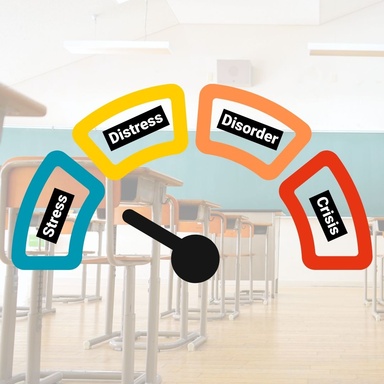Not too long ago, I had this conversation with a professor:
Professor: I have a student in my office crying. He needs to speak to someone at the counseling center immediately.
Barry: What happened?
Professor: He just found out his family dog was run over by a car.
Barry: I’m so sorry, truly. I’m not sure the student needs to go to the counseling center.
Professor: What do you mean? He’s very upset.
Barry: That makes sense, as something upsetting happened. This doesn’t mean he needs professional intervention. His upsetness, while feeling awful, doesn’t mean anything is wrong with him. He’s just responding to something clearly upsetting.
Professor: But what should I do?
Barry: Do you have a relationship with your student?
Professor: We’ve worked together for over two years.
Barry: Being upset doesn’t mean crisis even when we are reasonably, albeit uncomfortably, upset. Bad things feel badly. In these cases, we often just need to talk to someone we know.
Professor: Makes sense when you say it that way. He’s upset but is not falling apart. What do I say?
Barry: I have some suggestions.
Gauge of Stress to Crisis
When we experience a colleague, student, friend, ourselves, or anyone else who is stressed or distressed, we can jump quickly to "this person needs professional help.” When someone experiences upset emotions, it is important to differentiate along the Gauge of Stress to Crisis:

Stress
Upset feelings in response to challenges that require attention and need effort, i.e., “I’m really stressed out because I have a big project due tomorrow.”
Distress
Upset feelings in response to a situation that is occurring, i.e., “I’m really upset and sad because I just found out I got bad grades this semester.”
Disorder
Upset feelings long after the original situation has ended, i.e., “Got bad reviews at work. I never do well. What’s the point? I mess it all up. I’ve been so angry and disappointed with myself these past few weeks.”
Crisis
Upset feelings regardless of situation, resulting in possible/actual threat to self or others, i.e., “I give up. I see no purpose or point. I don’t care anymore. It’s the end.”
Tips for Managing Emotionality
Media tell us too often that we are more anxious and depressed than we’ve ever been. These are both categories of diagnoses that do not always accurately represent how we feel. If we pay close attention to the world, it’s easy to feel stressed and distressed in response to things that are simply upsetting. When we are told too many times, however, that we are depressed or anxious, we can wonder, “What is wrong with me?”
A few tips for managing the common emotionality of living:
1. Use the Gauge
When experiencing your own upset or the upset of someone else, gauge where you think it is along the continuum. Frame that there may not be anything wrong with you or the other person; they may simply be “upset about things that are upsetting” or “stressed about things that are stressful.”
2. You Got to Articulate It, Yo!
Most day-to-day upsets do not need professional intervention. Upset does not mean crisis. If you or another are upset, reach out to trusted supports. If you use the gauge and decide you or the other person are having stress and/or distress, this is reasonable. Nothing is necessarily wrong with you or the other person. Sharing stress and distress with others helps them help you, and we may find out we are not alone when we struggle.
3. How Bad is This???
If you’ve ever spent time with young children, you probably know when they inevitably fall down, the first thing they do is look at the closest adult in a split-second decision-making moment, searching the face of this adult for “how badly hurt am I because of this fall?” Our reaction can make it worse or can ease it. When someone is upset around you:
- Lean in and ask them, “What’s happening?”
- Ask them how they feel and share your own experiences with such things.
- Normalize that stress and distress are reasonable, albeit unpleasant, responses to the ebbs and flows and tensions of daily life. It is one thing to be upset; it is even worse to be upset about being upset. Normalize, rather than panic!
4. Resources, Resources, Resources
When we are in disorder or crisis, campus mental health services do have resources to help. While the overall theme of this is avoiding unnecessarily turning “simmer to boil” by how we frame it, sometimes we do boil. Like when we are not feeling well physically, we can reach out for help when we or someone else is not feeling well mentally.
Physician and founder of stress theory, Hans Selye, stated, “It is not stress that kills us, it is our reaction to it.” Recognize stress and distress, understand what may be happening for us and others, and lean into campus and community resources in those moments when we do need professional help.
Working in higher education is often described as a “calling.” Sometimes, however, it feels like being summoned to a never-ending meeting with no snacks and a PowerPoint titled “Strategic Realignment of Synergies.” Regardless of whether you are staff or faculty, disappointments can inevitably be part of this calling.
Maybe your carefully crafted proposal was rejected with a one-line response. Maybe your department’s budget was “reimagined” into something other than your priorities. Maybe you spent three weeks preparing for a workshop that was attended by only two students, one of whom was looking for something else and only wanted directions. Workplace disappointment is real and, across time, can make its mark on us.